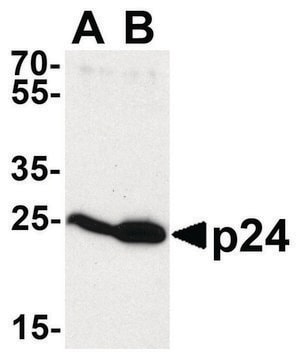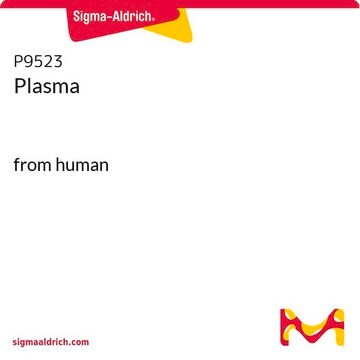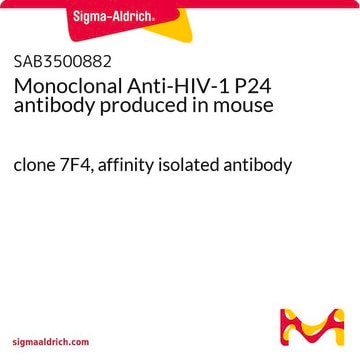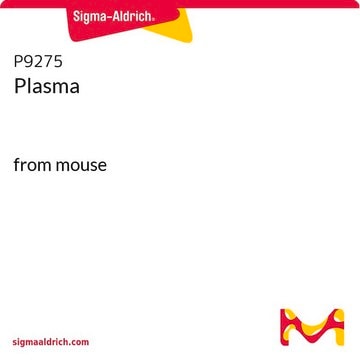H0160
HIV-1 gag
≥95% (SDS-PAGE), recombinant, expressed in E. coli, Galactosidase-tagged
Synonym(s):
p24 HIV antigen
Sign Into View Organizational & Contract Pricing
All Photos(1)
About This Item
Recommended Products
recombinant
expressed in E. coli
Quality Level
Assay
≥95% (SDS-PAGE)
mol wt
39 kDa (plus 114 kDa β-Gal tag)
concentration
1 mg/mL
UniProt accession no.
storage temp.
−20°C
Gene Information
human immunodeficiency virus 1 ... gag(155030)
General description
Contains amino acid residues [77-436] of HIV-1 gag antigen.
The human immunodeficiency virus 1 (HIV−1) gag antigen is a recombinant 39 kDa protein encoded by the GAG gene of the human immunodeficiency virus (HIV) type I expressed in and isolated from Escherichia coli. It has a β−galactosidase tag (114 kDa) on the N−terminus. HIV-1 Gag exists as monomers or lower-order oligomers in the cytosol. At the plasma membrane, it forms higher-order multimers.
Application
HIV-1 gag has been used in the coculture with an autologous cluster of differentiation T (CD4+ T) to study the ability of monocyte-derived dendritic cells (MDC1) to induce human immunodeficiency virus 1 (HIV−1) latency reversal (LR).
Biochem/physiol Actions
The human immunodeficiency virus 1 (HIV−1) gag (p24) antigen reacts strongly with HIV positive serum and may be used as a positive control for evaluating antibodies to HIV. At transcription sites, HIV-1 Gag creates ribonucleoprotein complexes with unspliced viral RNA. The HIV-1 Gag protein is accountable for packaging genomic RNA (gRNA) and the assembly of immature viral particles.
Positive control for HIV antibodies.
Physical form
Solution in 8 M urea, 20 mM Tris-HCl, pH 8.0, 10 mM 2-mercaptoethanol.
Storage Class Code
10 - Combustible liquids
WGK
WGK 2
Flash Point(F)
Not applicable
Flash Point(C)
Not applicable
Certificates of Analysis (COA)
Search for Certificates of Analysis (COA) by entering the products Lot/Batch Number. Lot and Batch Numbers can be found on a product’s label following the words ‘Lot’ or ‘Batch’.
Already Own This Product?
Find documentation for the products that you have recently purchased in the Document Library.
Samantha Sarni et al.
The Journal of biological chemistry, 295(42), 14391-14401 (2020-08-21)
The HIV-1 Gag protein is responsible for genomic RNA (gRNA) packaging and immature viral particle assembly. Although the presence of gRNA in virions is required for viral infectivity, in its absence, Gag can assemble around cellular RNAs and form particles
C T Wang et al.
Journal of medical virology, 59(2), 180-188 (1999-08-25)
The incorporation of human immunodeficiency virus type 1 (HIV-1) Gag-beta-galactosidase (Gag-beta-gal; GBG) fusion proteins into HIV virus-like particles in the presence of HIV Gag proteins was studied. HIV Gag-beta-gal fusion constructs were cotransfected individually into COS7 cells with or without
Xiaoling Zhang et al.
Cancer biology & medicine, 17(2), 418-432 (2020-06-27)
Objective: Bevacizumab is a recombinant humanized monoclonal antibody that blocks vascular endothelial growth factor (VEGF) with clear clinical benefits. However, overall survival of some cancer types remains low owing to resistance to bevacizumab therapy. While resistance is commonly ascribed to
Kevin M Tuffy et al.
Viruses, 12(11) (2020-11-14)
The ability of the retroviral Gag protein of Rous sarcoma virus (RSV) to transiently traffic through the nucleus is well-established and has been implicated in genomic RNA (gRNA) packaging Although other retroviral Gag proteins (human immunodeficiency virus type 1, HIV-1;
Jan Kristoff et al.
EBioMedicine, 43, 295-306 (2019-04-07)
Despite the success of antiretroviral therapy (ART), latent HIV-1 continues to persist in a long-lived population of resting memory CD4+ T cells within those who are infected. Finding a safe and effective means to induce latency reversal (LR) during ART
Our team of scientists has experience in all areas of research including Life Science, Material Science, Chemical Synthesis, Chromatography, Analytical and many others.
Contact Technical Service








